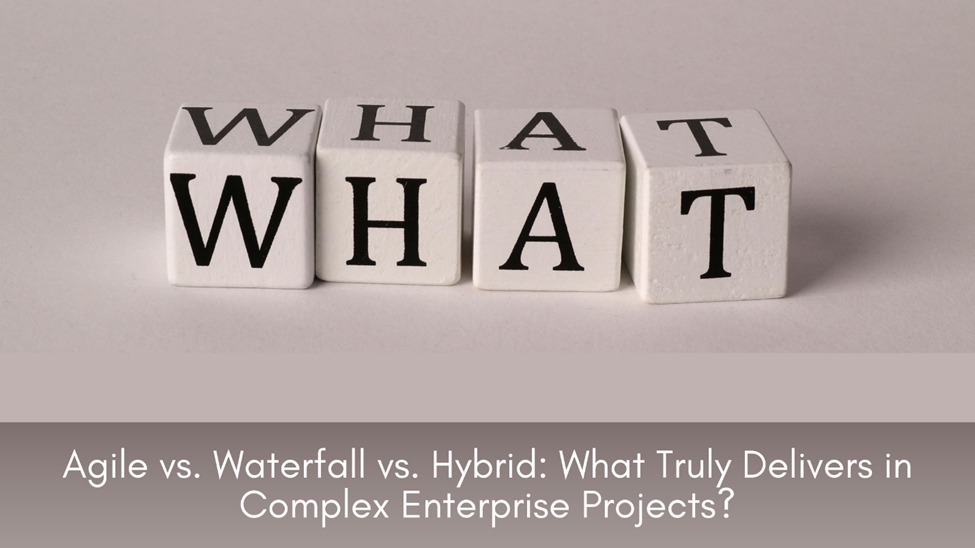

Project management methodologies have been a topic of debate for decades, especially when it comes to handling complex enterprise projects. Organizations constantly seek the most effective approach that ensures efficiency, agility, and successful outcomes. But which methodology truly delivers? We recently conducted a poll to gather insights from industry professionals, and the results revealed a clear trend:
- Hybrid Approach: 40%
- Pure Agile: 33%
- Depends on Context: 21%
- Traditional Waterfall: 5%
These results indicate a strong inclination toward a flexible, adaptive project management style. In this blog, we will explore these methodologies in-depth and analyze why Hybrid has emerged as the preferred choice for complex enterprise projects.
Understanding the Three Major Approaches
- Traditional Waterfall: A Structured & Sequential Model
Waterfall is one of the oldest project management methodologies, based on a linear, step-by-step approach. It follows a structured sequence: requirement gathering, design, implementation, testing, deployment, and maintenance. Each phase must be completed before moving to the next, making it suitable for projects with well-defined requirements and minimal scope for change.
Pros of Waterfall:
- Clear documentation and structured process.
- Easy to manage and follow.
- Works well for projects with fixed deliverables and regulatory compliance.
Cons of Waterfall:
- Inflexible to changes once a phase is completed.
- Late-stage testing often leads to increased costs if issues arise.
- Not suitable for dynamic or iterative projects.
Given these constraints, it’s no surprise that only 5% of respondents favored this approach.
- Agile: Embracing Flexibility and Continuous Improvement
Agile emerged as a response to the rigid nature of Waterfall. It promotes iterative development, frequent feedback loops, and adaptive planning. Agile methodologies, such as Scrum and Kanban, allow teams to respond to changes quickly and deliver incremental value throughout the project lifecycle.
Pros of Agile:
- High adaptability to changing requirements.
- Continuous feedback and improvement.
- Enhanced collaboration and faster time-to-market.
Cons of Agile:
- Requires high stakeholder involvement.
- Can be challenging to implement in large enterprises.
- Lack of formal documentation can create alignment issues.
Despite these challenges, 33% of respondents favored Agile, indicating its strong foothold in the project management world.
- Hybrid Approach: The Best of Both Worlds
With 40% of votes, the Hybrid approach emerged as the most preferred methodology. But what makes it so effective for complex enterprise projects?
Hybrid methodology combines the structured planning of Waterfall with the flexibility of Agile. This means that while high-level planning and critical milestones are defined upfront (Waterfall), execution and development cycles remain iterative and adaptable (Agile).
Why Hybrid Works for Enterprises?
- Predictability with flexibility: Enterprises often require a structured approach for governance and compliance, but they also need agility to accommodate evolving requirements.
- Risk Mitigation: By integrating Agile’s adaptability with Waterfall’s structured approach, organizations can manage risks better.
- Scalability: Hybrid is more suitable for large-scale, multi-team environments where some functions benefit from Agile, while others require a traditional approach.
For instance, an enterprise software development project might use Waterfall for defining security and compliance requirements while using Agile for iterative feature development and user testing.
Why the “Depends on Context” Vote Matters
Interestingly, 21% of respondents acknowledged that the best approach depends on the context. This highlights the reality that no one-size-fits-all methodology exists. Factors like industry type, project scope, regulatory requirements, and team dynamics all play a critical role in determining the right methodology.
When to Choose Which Approach?
- Waterfall: Best for government projects, compliance-driven industries, and construction projects.
- Agile: Ideal for software development, startups, and projects requiring frequent updates.
- Hybrid: Suitable for enterprises with cross-functional teams and evolving business needs.
Conclusion: The Future of Project Management Lies in Hybrid Models
The poll results reinforce a significant shift in project management trends. While Agile remains a strong contender, organizations recognize the need for a balanced approach, making Hybrid the most preferred choice for complex enterprise projects.
As businesses continue to evolve, project management methodologies must evolve too. Hybrid models offer the right mix of structure and agility, ensuring better alignment with business goals, improved risk management, and enhanced adaptability.
What’s your experience with these methodologies? Have you seen success with Agile, Waterfall, or Hybrid in your projects? Share your thoughts and let’s keep the conversation going!


